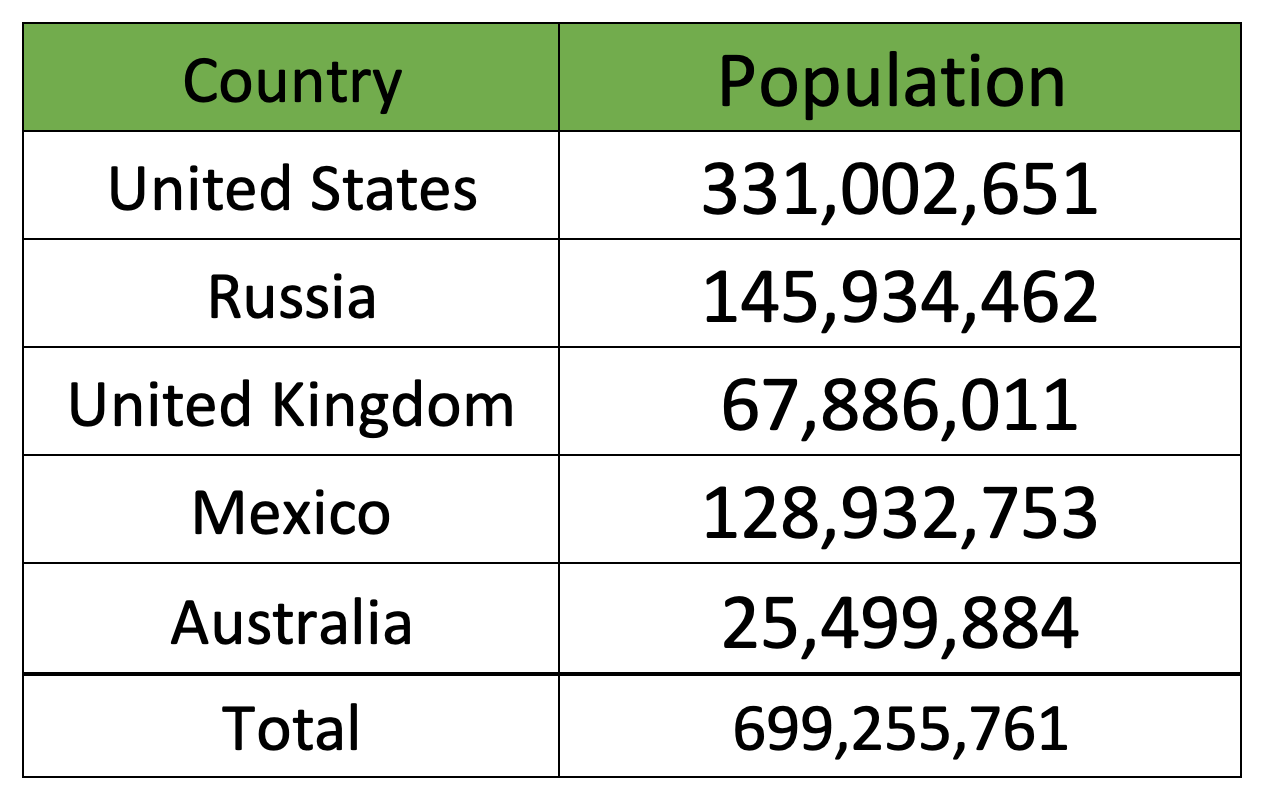 At the end of 2018, 5.1 billion people across the world owned a mobile device subscription, and it is estimated that by 2025 this number will grow to 5.8 billion. A 4% growth rate may not seem like much off the cuff but if this prediction actualizes, 700 million people who did not have access to mobile devices in 2018 would gain access by 2025. To put this in perspective, 700 million people is more than the population of the United States, Russia, the United Kingdom, Mexico, and Australia combined.
At the end of 2018, 5.1 billion people across the world owned a mobile device subscription, and it is estimated that by 2025 this number will grow to 5.8 billion. A 4% growth rate may not seem like much off the cuff but if this prediction actualizes, 700 million people who did not have access to mobile devices in 2018 would gain access by 2025. To put this in perspective, 700 million people is more than the population of the United States, Russia, the United Kingdom, Mexico, and Australia combined.
That is a massive number of people, but it is important to note that growth is not coming equally from all regions of the world. For this reason, we will examine and compare the landscapes of mobile phone penetration in regions across the globe in this post.
Considerations when discussing mobile penetration
Throughout this post, we will take a look at mobile penetration in regions across the world. Seeing as mobile penetration can be interpreted as a few different concepts, for the purpose of this post it is defined as unique mobile phone owners.
It is important to keep in mind that methodologies for measuring mobile penetration are not perfect. In an ideal world, mobile penetration studies would be conducted through face-to-face data collection. Data collection of this nature on a global scale is incredibly costly and time-consuming. For this reason, publicly available studies on the topic present data that was gathered primarily from the mobile network operators themselves, which means a margin of error may be present.
Additionally, when discussing mobile penetration by region on a global scale, the statistics will show averages of mobile phone ownership rather than more granular views of where mobile penetration is concentrated or diluted. Furthermore, in certain areas of the world, there are complexities regarding mobile penetration—like societies where it is common to share a single mobile device with friends and family—that are not outlined with each presentation of statistics.
Projected Growth in Global Mobile Penetration

Information in this graphic sourced from GSMA’s Global Mobile Economy Report
The quickest growth in mobile penetration is coming from Africa, Latin America, the Middle East, and the Asia Pacific. In these regions, basic mobile technology is becoming increasingly accessible to the masses. This growth is not only because of technological development that occurred or structural changes that took place but also because of a phenomenon that has been referred to as “leap-frogging”.
In essence, regions that were low-tech 15-20 years ago are adopting mobile telecommunications technology today by purchasing low cost mobile phones. These mobile phones are only affordable options today due to years of technological development in regions like North America and China. Years of product development and research took the technology from expensive, bulky desktop computers to advanced handheld mobile devices. During that time, simple mobile phone devices became exponentially cheaper to produce, distribute, and use in locations without structure for wired technology. Today, populations in regions like Africa and Latin America have been able to leap-frog over the process of developing wired telephone networks and instead move toward digital inclusion by purchasing rather affordable mobile phones.
Mobile Penetration Growth in Sub-Saharan Africa
Sub-Saharan Africa is still in the midst of stabilizing after economic struggles that have inhibited strong GDP growth in the past few years. Despite the lull in GDP growth, the digital exodus to mobile phone ownership in SSA has surged. In fact, the growth in the digital space in the region is significantly exceeding GPD growth.
As for the hard numbers, it has been predicted that the number of unique mobile subscribers will rise from the 641 million seen at close of 2018 to 871 million by the close of 2025, which is a 6% increase.
Mobile Penetration in North America
At the end of 2018, North America had 321 million unique mobile subscribers. By 2025, the penetration rate is expected to increase by 2% to 345 million unique mobile subscribers.
Mobile Penetration in the Middle East and North Africa
The mobile penetration in the Middle East and North Africa is on the lower end compared to other regions in the world but growing rapidly. At the close of 2018, there were 382 million unique mobile subscribers and that number is expected to rise to 5% by the close of 2025 to 459 million unique mobile subscribers.
Mobile Penetration in Latin America
It has been predicted that Latin America’s unique mobile subscribers will increase 6% from 416 million in 2018 to 484 million in 2025, which indicates that Latin America’s mobile phone market is one of the fastest growing markets in the world.
The growth in Latin America’s mobile phone market may be affected in the coming years by inter-industry competition of telecom operators and government regulations. Currently, there are large, international telecom companies competing with smaller, local telecom companies, which has garnered attention from national governments. Governments in certain countries have implemented regulations that hold larger telecom operators back from taking over the markets. Without large telecom companies, mobile phones may be costlier for users and inhibit the mobile penetration growth rate. Due to these complexities, only time will tell how the industry develops in the years to come.
Mobile Penetration in Europe
The mobile sector in Europe is anticipated to contribute 720 billion euros to the global GDP by the end of 2022. Already high adoption rates are expected to continue growing and reach 481 million by the end of 2025, which would be up 3% from the close of 2017.
Mobile Penetration in Eastern Europe & Russia
Mobile penetration is high in Eastern Europe & Russia. As of the end of 2018, there were 235 million unique mobile subscribers in the area. By 2025 only 2% growth is anticipated, which would bring the count of unique mobile subscribers up to 244 million.
Mobile Penetration in APAC
In contrast to the current growth seen in other regions in the world, like Sub-Saharan Africa, the growth of mobile phone penetration in APAC has slowed after years of rapid uptake. In 2018 there were 2.8 billion mobile subscribers in the Asia Pacific. The penetration rate of the region is anticipated to increase by 5% by 2025, meaning a total of 3.1 billion projected mobile subscribers in the region.
Mobile Penetration in China
China is expected to reach 1.2 billion mobile subscribers by 2025. If these projected numbers actualize, a 3% increase in penetration rate would be seen during the 7-year span from 2018 to 2025, which is one of the lowest projected growth rates when compared to other regions globally.
Takeaways
People around the world are becoming more connected through mobile phone technology than ever before. At GeoPoll, we are experts in utilizing that technology to remotely engage mobile phone subscribers in research projects in African, Latin American, and Asian markets. To learn more about how the mobile phone can help your organization answer research questions, contact us today.



